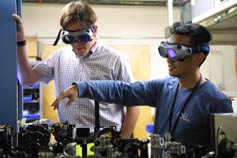
Handy Links
SLAC News Center
SLAC Today
- Subscribe
- Archives: Feb 2006-May 20, 2011
- Archives: May 23, 2011 and later
- Submit Feedback or Story Ideas
- About SLAC Today
SLAC News
Lab News
- Interactions
- Lightsources.org
- ILC NewsLine
- Int'l Science Grid This Week
- Fermilab Today
- Berkeley Lab News
- @brookhaven TODAY
- DOE Pulse
- CERN Courier
- DESY inForm
- US / LHC
SLAC Links
- Emergency
- Safety
- Policy Repository
- Site Entry Form

- Site Maps
- M & O Review
- Computing Status & Calendar
- SLAC Colloquium
- SLACspeak
- SLACspace
- SLAC Logo
- Café Menu
- Flea Market
- Web E-mail
- Marguerite Shuttle
- Discount Commuter Passes
-
Award Reporting Form
- SPIRES
- SciDoc
- Activity Groups
- Library
Stanford
Around the Bay
Photons on the Half Shell
 In the realm of ultra-fast science, there's a region where photons of light can be made to dance only half steps. Here, advances in laser science are letting researchers tinker with the behavior
of light in an entirely new way.
In the realm of ultra-fast science, there's a region where photons of light can be made to dance only half steps. Here, advances in laser science are letting researchers tinker with the behavior
of light in an entirely new way.
"It's a really new regime for studying materials properties," said Aaron Lindenberg of SLAC's PULSE Center and the Stanford Materials Science and Engineering Department. "We’re just learning how to create such intense fields in this relatively simple way."
Lindenberg's team is pioneering a technique that creates highly intense beams of low-energy infrared photons, separated into extremely short pulses lasting less than a trillionth of a second (one picosecond). These "terahertz fields" show promise as a powerful tool for manipulating matter at the atomic level.
Terahertz fields are nothing new. Very weak terahertz pulses are emitted when electrons shift around naturally inside molecules, and they emanate from electrons inside accelerators. Lindenberg's team is combining this phenomenon with a high-power laser that can be switched on and off very rapidly, creating terahertz fields of unprecedented intensity.
Just like ordinary visible light, infrared photons exist as both particles and waves. As waves, they take the form of electromagnetic oscillations, a rapid push–pull in the electromagnetic environment that rises and falls extremely rapidly. For visible light, these oscillations occur hundreds of trillions of times a second. Now, using a combination of commercially available lasers and optics, Lindenberg's team has devised a way of generating photon pulses that can be switched on and off in roughly half the time of one oscillation. The result is only half an oscillation—all of the push, with none of the pull.
"It's like a hammer," says Lindenberg. "You can use these pulses to give a kick to something, to push it one direction. They could be used to push an electron from one position to another."
Once the phenomenon is more fully understood, it could be used to probe alternative-energy-related materials used in solar cells. Within semiconductors, the motion and speed of electrons changes very rapidly. Manipulating and measuring how these electrons move around could lead to more efficient solar cells, and could improve the efficiency of the production of hydrogen from water. Terahertz pulses might also be used to drive ultrafast switches for computer memory, which could dramatically increase computing speed.
Interest in terahertz pulses has risen in the last decade with the advent of free-electron lasers (FELs), such as the Linac Coherent Light Source now under construction at SLAC. FELs generate extremely intense terahertz fields as a by product of how they accelerate electrons.
"We're at a very early stage," says Lindenberg. "There's a lot of controversy out there about exactly how this process works. Part of what we're doing is trying to understand that… and maybe by understanding that we can generate stronger fields and manipulate and control materials in new ways."
—Brad Plummer, SLAC Today, August 16, 2007
Above image: Aaron Lindenberg (left) with Haidan Wen, who designed the optical layout used to create terahertz pulses.